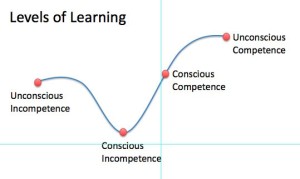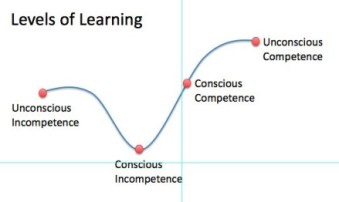I remember early in my sales career, one of my managers explaining the phases of competence that one progresses along when learning a new skill, and in that case, my new job. It made so much sense to me and allowed me at any point in my learning’s to objectively evaluate and discuss with her the phase I was experiencing. I used this competency phase matrix with other positions and with employees when I was managing individuals and teams and it seemed to resonate as a tool for objectively discussing progress.
 The Conscious Competence learning model was developed by Gordon Training International but is frequently attributed to Abraham Maslow, despite not appearing in his works. I like this model because it allows for a self reflective matrix in which a new student can build skills and learn new tools as well as the contextual knowledge of when to use them, and identify their progress. We all learn at different rates and in different ways. This model allows for all the different types of learners and it allows for time to become self aware of ones mastery. The conscious and unconscious aspects of learning are always present and having a tool to identify and navigate the stages more adroitly can help us stay engaged in the learning.
The Conscious Competence learning model was developed by Gordon Training International but is frequently attributed to Abraham Maslow, despite not appearing in his works. I like this model because it allows for a self reflective matrix in which a new student can build skills and learn new tools as well as the contextual knowledge of when to use them, and identify their progress. We all learn at different rates and in different ways. This model allows for all the different types of learners and it allows for time to become self aware of ones mastery. The conscious and unconscious aspects of learning are always present and having a tool to identify and navigate the stages more adroitly can help us stay engaged in the learning.
In one of my current endeavors, I am finally feeling like I am dipping into the Unconscious Competence phase of my work. I am finally teaching others to do what I do and teaching them ways that work for them and their style. I found this is important as everyone has a different experience and approach to their work and learning. I am also aware of the stages of their learning and see their reactions in the ways that I also reacted. In any new job or skill there are the things that you just don’t know yet until you do them or experience them. But once you experience them, you add that experience and the context of it to your knowing and you can use that experience to move along the path of learning competence.
The phase of the Conscious Leaning Model are described below:
- Unconscious incompetence
- The individual does not understand or know how to do something and does not necessarily recognize the deficit. They may deny the usefulness of the skill. The individual must recognize their own incompetence, and the value of the new skill, before moving on to the next stage.[2] The length of time an individual spends in this stage depends on the strength of the stimulus to learn.[3]
- Conscious incompetence
- Though the individual does not understand or know how to do something, he or she does recognize the deficit, as well as the value of a new skill in addressing the deficit. The making of mistakes can be integral to the learning process at this stage.[4]
- Conscious competence
- The individual understands or knows how to do something. However, demonstrating the skill or knowledge requires concentration. It may be broken down into steps, and there is heavy conscious involvement in executing the new skill.[3]
- Unconscious competence
- The individual has had so much practice with a skill that it has become “second nature” and can be performed easily. As a result, the skill can be performed while executing another task. The individual may be able to teach it to others, depending upon how and when it was learned.
